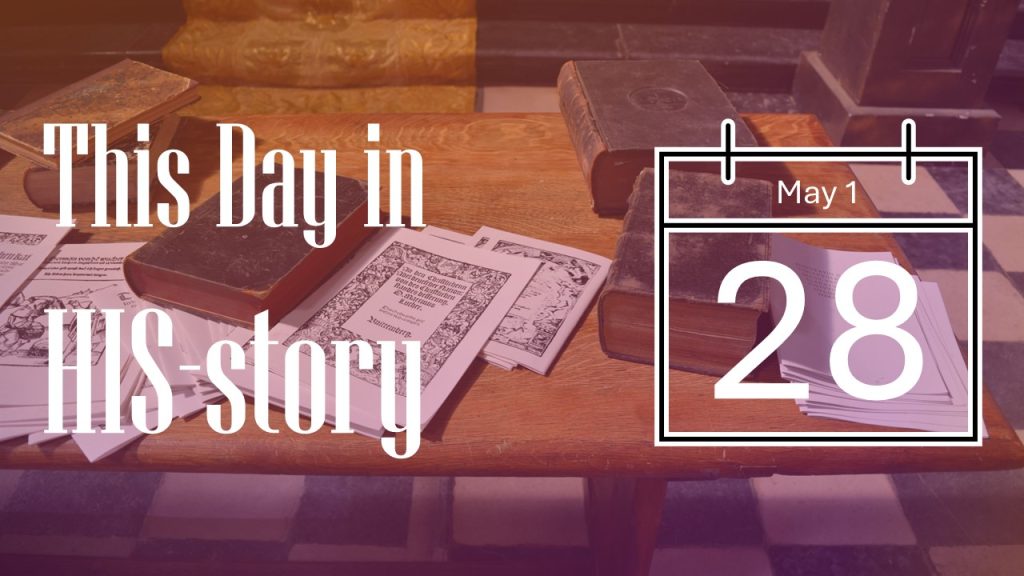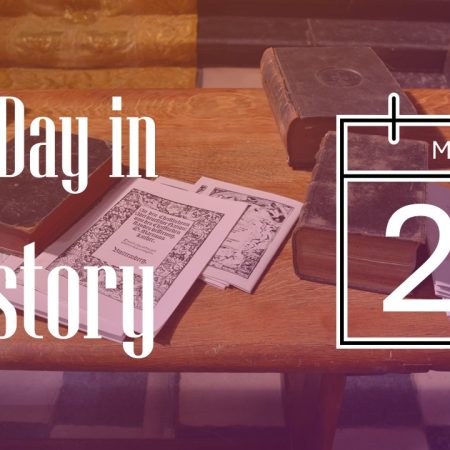
1663
When Jospeh Alleine‘s older brother Edward died, Joseph underwent a spiritual crisis, what he would call a “thorough conversion.” Edward had been studying for the ministry and Joseph pleaded with his father to be allowed to take his place. His father agreed and Joseph headed off to school.
The young man proved to be a diligent scholar, took his B.D. and, after becoming a tutor, turned down a fellowship at Corpus Christi College, preferring to serve as chaplain. He also turned down enticing offers to work for the state. He had fixed his mind on the ministry and nothing else would do.

Soon he was settled at Taunton as an assistant pastor to a Puritan congregation. He married about the same time. Observers gave a good report of his private life.
Joseph was fascinated with science. He would not neglect his duties and so he gave up sleep to make experiments and write a book showing that science confirms Scripture. That manuscript is lost, but not so Joseph’s major work, An Alarm to the Unconverted (also published as the Sure Guide to Heaven).
This was an earnest appeal to unconverted sinners. A characteristic passage from Alleine reads: “Oh, better were it for you to die in a jail, in a ditch, in a dungeon, than to die in your sins… Your sins will follow you when your friends leave you, and all worldly enjoyments shake hands with you. Your sins will not die with you as a prisoner’s other debts will; but they will go to judgment with you there to be your accusers; and they will go to hell with you there to be your tormentors.”
The answer to the condition of sin is found in Christ. “Can any other but Christ save you? and He tells you He will never do it except you be regenerated and converted. Does He not keep the keys of heaven, and can you go in without His leave?…”
When the Act of Uniformity ordered Puritans to conform to the Church of England or get out of the pulpit, Joseph was one of over 2,000 English pastors evicted. However, he kept right on preaching. Since he did so within 5 miles of his former pulpit, he was in violation of the law. On this day, May 28, 1663, he was thrown into prison. He remained jailed for almost exactly a year. Over the next few years He went back to prison several more times until, worn out from overwork and abuse, he died at the early age of thirty-four. He is regarded as one of the most beloved Puritan writers.
Famous Christians such as Charles Spurgeon and George Whitefield testified that Alleine’s Alarm helped bring them to Christ. It is still in print.
1685
James Renwick and about 200 men meet in Sanquhar, Scotland, where they will draft the Second Sanquhar Declaration which claims that King James II of England (VII of Scotland) is a murderer and an idolater and that acts of Parliament and Scottish church law make him ineligible to hold the kingship because he is a Catholic.

1938
After a giddy youth in which dances and flirtations had a prominent part, vivacious Canadian Isobel Selina Miller drifted into agnosticism and even contemplated suicide. But then she turned back to Christian faith and made up her mind to follow God wholeheartedly. Isobel heard a missionary speak of the satanically oppressed Lisu tribes of Southeast Asia, who had not a word in their language for compassion, forgiveness, mercy, or justice–but hundreds of words to describe the best way to skin someone alive. Isobel pleaded with the Lord to be allowed to serve them as a missionary.

“If you go to China it will be over my dead body,” said Isobel’s mother. Isobel was aghast. Her mother had raised her in the Christian faith and was a leader in missionary support. Now she was showing that personal affections mattered more to her than Christ’s work. What is more, Isobel felt she must obey her mother as the Bible commanded. She was truly perplexed, for God seemed to be calling her to China.
Miraculously the Lord provided the money she needed to attend Moody Bible Institute. Her mother’s opposition ended abruptly with death by cancer. On her death bed Mrs. Miller confessed that “Belle” (her daughter’s nickname) had chosen the better part and that her own works were as wood, hay, and stubble. Then John Kuhn entered Isobel’s life. A few years later they married. John shared Isobel’s vision and commitment. Through prayer and pluck the two achieved their goal of reaching the Lisu.
After years of labor, they had won few converts. Belle then had one of the most innovative ideas of their ministry. Why not set up Bible school during the rainy season? Little else could be done during that time. On this day, May 28, 1938, the first Rainy Season Bible School opened. The idea was successful beyond their wildest hopes. Thirty or so students became evangelists and reached distant villages for Christ. Many, on only a few weeks’ training, gave their lives for Christ. Some carried the gospel while sick.
Isobel and John suffered greatly in their ministry. Often they were threatened. Sometimes they were separated for as much as a year at a time. During World War II the Japanese held their young daughter in a concentration camp. Every kind of privation dogged their steps.
By God’s grace, they triumphed. Belle wrote eight books recounting her experiences with the Lord and his answers to prayer. Above all she wanted to overcome self and see souls won for Christ. “I would fall on my knees and weep before the Lord, asking for his help. And never did he spurn me. He was firm in correcting me but always loving. I have never attained the place where one is beyond the temptations of self. But I want to testify to what God can do to change a human being, one that found she was indeed — scum.” To the Lisu and the many who profited from her books she was a bright light.
1940
DURING THE EARLY YEARS of her life, Florence Selina Young, the daughter of Plymouth Brethren parents in New Zealand, lived in terror of Christ’s Second Coming. But when she was eighteen, attending a prayer meeting, she was suddenly able to apply the promise of Isaiah 43:25 for herself (I, even I, am he that blotteth out thy transgressions for mine own sake) and felt a surge of love for Christ. She felt free to partake of the Lord’s Table and to be baptized.
Immediately she began working for the Lord. In her first ventures teaching the Solomon Islanders who worked on plantations in Queensland, Australia she taught the gospel in pidgin English using pictures and a large-print New Testament. To explain the Resurrection, she used a chrysalis. Her efforts resulted in the formation of the Queensland Kanaka Mission. After several years working with Solomon islanders in Queensland, she turned the work over to others and joined Hudson Taylor’s China Inland Mission. She had become conversant with Chinese when events (including a nervous breakdown) forced her to return to Australia. However, her mission training would serve her well.

Beginning in 1900, the Christians in her circle were drawn by a desire to pray for the Holy Spirit. They felt the need to extend the Queensland work to the Solomon Islands and gradually brought it about. Young would eventually administer the South Sea Evangelical Mission and tour the islands repeatedly between 1904 and 1926. In 1904 Young made her first trip to Malaita, largest of the Solomons. But the start of the mission work was plagued with difficulties, including attacks of malaria that prostrated all the missionaries. Young was forced to return to Australia. However, other workers were able to obtain land and build a mission house.
Meanwhile, revival broke out in 1905 among the Solomon Islanders working in Queensland. The men prayed long hours, and sought the filling of the Spirit of God. That same year, despite warnings of danger, Young visited Malaita again to encourage indigenous workers. The serious difficulties and dangers faced by sailboats caused the missionaries to pray for a motorized boat. When Young addressed a 1906 meeting in Sydney, Australia, she sensed that some surprise was in the works. It was: the assemblage presented her with £417 they had secretly raised toward purchasing just such a boat.
In 1907, the Queensland work ended because Australia’s recruitment laws had changed, requiring the planters to send the Solomon Islanders home. Young and other missionaries toured the islands in their motor-powered boat, taught in villages, called the fallen back to Christ, provided medical care, and operated training centers. The work was arduous and fraught with danger. Because of long-established blood feuds, many Christian workers met violent deaths. Others died of common hazards: storms, drownings, malaria, and untreated medical conditions.
However, the islanders themselves learned to preach simple but effective messages. One, preaching on 2 Corinthians 5:7 (If any man be in Christ, he is a new creature) said in pidgin English:
Suppose you savee [know] about Jesus, [does] that save you? No. Plenty white man savee Jesus along [i.e.: in the] head. That no good. We must believe in Jesus along heart.” He compared knowing Jesus to knowing a certain missionary who was currently away in Australia but would soon be back. So would Jesus be back. “By-and-by He come, we look along face belong Him and then we plenty glad!
A wonderful testimony to God’s power came in 1909 when an old and filthy witchdoctor—a man so evil he had cooked and eaten his own wife—came to Christ. The woman’s son had fled when ordered to fetch water to cook his mother. After signing up to work on a plantation he had become a Christian, returned home, and brought his father to hear the gospel.
By the time of Florence Young’s death, on this day 28 May 1940, in Killara, New South Wales, 7,900 islanders had come to Christ.

0 Comments